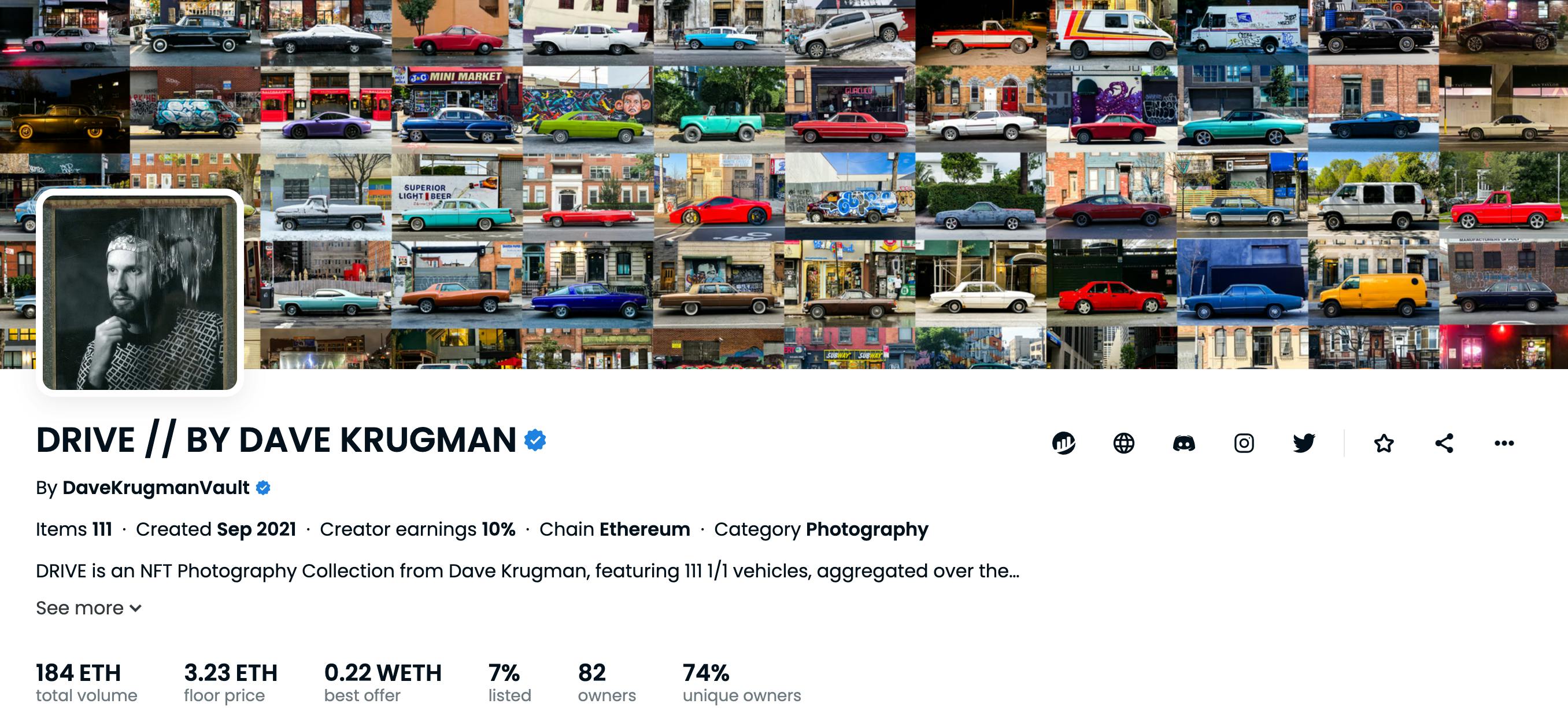What is NFT Photography? An Introductory Guide.
Understand the Basics and its Impact on the Art Industry.
At Explorest, we are constantly inspired by the intersection of creativity and technology. We couldn’t be more thrilled to be at the forefront of the revolutionary emergence of NFT photography. Since 2017, we have built a community of 250,000+ passionate photographers and travelers who discover the world's most awe-inspiring locations through our travel app. In Web3, Explorest collects, promotes, and celebrates the works of NFT photographers—check out our Vault.
The rise of NFT technology has sparked a digital renaissance, as seen through the sale of Beeple's iconic "Everydays" piece at Christie's for millions and the entry of major companies like Google and Nike into Web3. NFTs give artists control of their work, but we at Explorest believe the technology can also enhance the experience and appreciation of our world to unprecedented levels of richness and depth.

What are NFTs (Digital Collectibles)?
Non-Fungible Tokens, or NFTs, are unique digital assets stored on a blockchain network that verify ownership of digital items such as artworks. These digital collectibles allow creators to establish a new income stream by "minting" their art on the blockchain so it can be sold to their fans. The use of blockchain technology ensures the authenticity and scarcity of the item, as well as provides a way for creators to profit from their digital creations.
Blockchain technology, in its essence, is a digital ledger that records transactions in a traceable and public manner, verified by thousands of individual computers, as opposed to a central authority like banks. The goal of blockchain is to decentralize authority and put it in the hands of people.
With the emergence of NFTs, creators can leverage this technology to establish a new income stream. Collectors can subsequently sell the crypto art they buy via secondary marketplaces such as Opensea.io, which can even generate royalty income for the artist. An example of this is Sebastião Salgago’s first foray into NFTs, where Sotheby's described his Sebastião Salgado: Amazônia collection as 'the most significant collection of NFTs by a living photographer.
The limited-edition run, comprising 5,000 unique photography NFTs and a short film, spans over a decade of Salgado's visits to the Amazon. All proceeds from the auction were donated directly to Instituto Terra, an environmental restoration non-profit co-founded by Salgado.
For most sales of digital collectibles, the artist receives payment from the original sale and a percentage of secondary sales of the piece, usually 10-15% in royalties, as collectors trade between themselves. In this example, Instituto Terra receives 10% in royalty commissions from sales of Salgado's pieces on the secondary market.
The ability to sell art as digital collectibles and NFTs opens a new avenue for creators to make a living by producing art. This has been an absolute game-changer in the art world, as many artists are now exploring this new medium to monetize their creations.

NFT Photography
What do NFTs have to do with photography? Can travel photographers use NFTs? Photography has one of the best use cases for NFT technology.
Making a living in the art world is tough! Exhibiting and selling art sustainably is often hindered by extortionately high gallery commissions, agent fees, and industry gatekeeping. It’s more complex than meets the eye.
NFTs empower photographers by giving them control over how they monetize their art. With blockchain technology, photographers no longer need to rely on third-party intermediaries like agents to support a sale. Instead, they can directly connect with new audiences, foster relationships with their supporters, and earn money directly. The technology also allows photographers to benefit from the resale of their art, which is not always possible through traditional art sales methods. Overall, NFTs provide a new, autonomous way for photographers to commercialize their work.
As noted by Explorest Contributor and NFT Photographer Dave Krugman, photography and blockchain technology complement each other exceptionally well. Photography has a long history of documenting the world through images, and blockchain technology has a similar function of documenting through blocks. Together, they create a powerful combination that can benefit photographers in terms of monetizing their art and reaching new audiences.
Digital collectibles, like NFTs, are revolutionizing the creative industries by providing artists with the ability to build royalties and payment terms into smart contracts. This concept is not entirely new, as artists have historically negotiated contracts with galleries that stipulate a percentage of resale value to be paid to the artist. However, these agreements are often difficult to trace and enforce, resulting in a loss of income for the artist.
Smart contracts on the blockchain, however, allow artists to set their own personalized terms and conditions. They also ensure that royalties are paid promptly and fairly, giving artists more control over their income.
Moreover, some photographers are using NFTs to give back to the community by incorporating them into grant proposals and donating a portion of sales to specific causes. This allows photographers to use NFTs not only as a way to monetize their work but also as a way to support causes that they care about.
Why do people buy Photography NFTs?
The burgeoning NFT landscape is an attractive prospect for photographers looking to further their professional, creative and financial autonomy. It also offers an opportunity for photographers to pursue forms of work they are passionate about but wouldn’t have been monetizable previously.
The rapidly growing NFT market presents a compelling opportunity for photographers looking to gain more control over their professional, creative, and financial endeavors. It allows photographers to explore forms of work that they are passionate about but were previously unable to monetize.
But why would the typical art lover—someone who often buys physical photography to display on their wall—want to buy a photography NFT (or digital collectible)?
1. Collect Art They Love
The primary reason to buy a photography NFT is similar to that of buying a physical print: to collect and own a piece of art that you love and admire. NFTs, or digital collectibles, serve the same purpose as physical artworks—but also offer the added convenience of easy storage and display.
So much of what we do is digital, from documenting our lives on Instagram to sharing our views on Twitter or Tiktok. Buying a photography NFT and sharing about it further reflects who we are and what we love.
In today's digital age, many aspects of our lives are already conducted online, whether it's sharing our experiences on Instagram and TikTok or expressing our opinions on Twitter. Buying a photography NFT and sharing about it is an extension of our digital lives and reflects our personal tastes, identity, and interests. It also allows us to connect with others who share the same passion for art.
2. Support Artists
Let’s take it back to basics. Supporting an artist by buying their NFT is one of the most direct and impactful ways to invest in their work and career. It helps them sustain themselves while also giving you the opportunity to be a part of their journey and growth as an artist.
When purchasing a photography NFT, the artist receives payment directly, with platforms like SuperRare and Foundation taking a commission of only 5-15% as compared to the standard 45% commission taken by traditional galleries.
If the NFT is resold on the secondary market, the artist also benefits through royalties, usually a percentage of the sale. For example, Galaxy Digital reported that Art Blocks, a generative crypto-art platform, has paid artists $82 million in royalties to date—let that value sink in!
3. Membership Utility & Exclusive Access to Future NFTs
Often, purchasing an NFT can often provide access to exclusive clubs or communities, which can offer unique opportunities such as exclusive access to physical artworks, limited-edition merchandise drops, or future NFTs that the artist mints.
Photographers use this technology to strengthen connections and establish intimate, mutually beneficial relationships with their audiences. The benefits are not one-sided, as fans of certain artists can gain special access to their favorite creators, including personal insights, previously unreleased material, and more. This creates a deeper connection between the artist and their audience, making the art experience more personal and meaningful.
4. Invest and Make Money
Just as physical photography can be purchased as an investment, the same holds true for photography NFTs. Art dealers and collectors often seek out quality and scarcity as key indicators of present and future value.
However, it can be difficult to verify the authenticity and uniqueness of a physical print.
With physical photography, there is always a possibility that there may be other examples of the same photograph or that there may be undiscovered works by the same artist that could impact the valuation of the piece. This uncertainty is eliminated with NFTs, as they provide a transparent and verifiable record of the number of pieces in circulation, ownership and authenticity.
For many collectors and investors, having a piece of art to admire may not be as important as the ownership of it. This is a controversial motivation, as many believe that art should be purchased out of personal admiration rather than for financial gain. Nevertheless, it is important to acknowledge that art also has monetary value, and NFTs provide a reliable and secure means of verifying and authenticating ownership.
5. Commercial Use
Some artists may allow buyers of their NFTs to use them for commercial purposes. For instance, a travel company may purchase an NFT and use the image in its brochures or website. Similarly, a publishing house may buy an NFT and use the image as cover art for an upcoming novel.
However, it is important to note that commercial rights are not always included in the sale of an NFT, and photographers must clearly state within the smart contract or the asset's description whether or not commercial and copyright permissions are included.
While many NFT photographers have not yet explored this avenue, licensing image copyright can potentially become a driving motivation for buyers. This is also one of the reasons why projects like CryptoKitties and Bored Ape Yacht Club (BAYC) have become so popular and profitable. The ability to unlock IP rights and use the NFT for commercial purposes was a major draw for buyers. For example, BAYCs have been used to decorate crypto-friendly restaurants, made cameos in music videos, and even been used to create virtual bands (don’t ask!).
6. Physical Prints
Finally—for the traditionalists! NFTs are inherently digital, but they’re not limited to this form. Digital collectibles can be sold with accompanying physical artwork.
For example, some platforms like ART3.io offer a physical print of the artwork along with the digital NFT. This allows for a fusion of traditional and digital art forms, offering a unique and innovative experience for collectors.
Traditional artists, such as Damian Hirst, have been exploring new possibilities by offering buyers the choice between a physical artwork or an NFT, and even destroying the physical piece if the NFT is chosen. His foray into Web3 and NFTs received mixed reviews, but it did spark new conversations around scarcity, rarity, and how they relate to digital collectibles. Hirst's innovative collection exemplifies the capabilities of tokenization, seamlessly bridging the gap between the tangible and virtual realms of art.
Which Travel Photographers are Selling NFTs?
The travel photography NFT category may be small within the larger Web3 ecosystem, but it's rapidly gaining momentum. The photographers leading the charge in this space possess exceptional talent and are pushing the boundaries of what's possible with this technology.
Dave Krugman, a pioneer in the world of NFT photography, released DRIVE, a collection of 111 unique vehicle images curated from a decade of street photography. Not only do the buyers of these NFTs gain ownership of one-of-a-kind digital artwork, they also gain access to an exclusive community game and the opportunity to participate in a variety of exciting future projects presented by Krugman.
Budding young talent, Ben Skaar, has been cooking up some incredible on-chain offerings. Skaar’s inaugural ‘Cinema in the Sky’ series offers a birds-eye view of some of the most breathtaking corners of the planet. The collection is completely sold out, with more pieces on the way in 2023.
Bree Rose, commonly known as @eyeofshe, has ethereal snaps that both celebrate adventure and provoke a dreamy, delicate stoicism—an impressive balance that she strikes impeccably. Check her Foundation collection and own a piece of these moments in time—captured high up in the Italian Dolomites.
Chad Torkelsen’s Green World collection is an ode to his childhood and the natural environment. The 100-piece series spans the luscious plains of 15 countries. Working within this emerging arena has provoked many artists to redefine their creative parameters and embrace new techniques. This is true for Torkelsen, whose 9-part visual album, DRΞAMER, is a captivating exploration of multimedia realms.
In the coming weeks, we'll take a closer look at other standout NFT travel photographers who are not only making a name for themselves in Web3, but are also contributors to Explorest. Proud? Yes. Inspired? Tick!
What’s next? The Explorest Travel Membership NFT.
For the past six years, Explorest has demonstrated its ability to partner with world-class photographers, curate exceptional photography for our travel discovery app, and establish partnerships with leading travel and lifestyle brands.
Now, we're thrilled to share that we're taking our travel photography game to the next level and embracing the future of digital art by launching our very own Travel Membership NFT.
With the guidance and support of a network of forward-thinking Web3 experts, creators, collectors, and investors, we're building an innovative platform that combines our Web2 foundation with the limitless potential of blockchain technology.
This is just the beginning of our journey in the world of NFTs, and we can't wait to unveil the exciting new possibilities it holds for travel photographers and the industry as a whole.
Stay tuned—it's going to be a wild ride!
image credit: starline (metaverse skateboarder)



